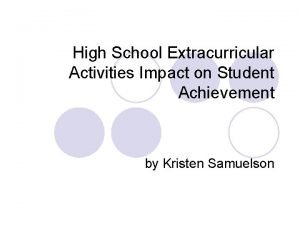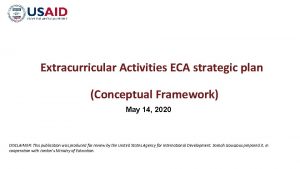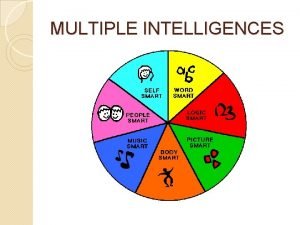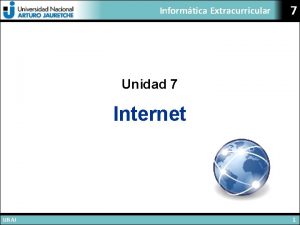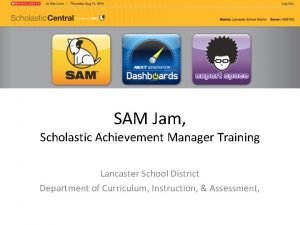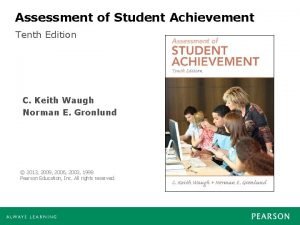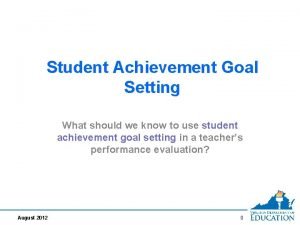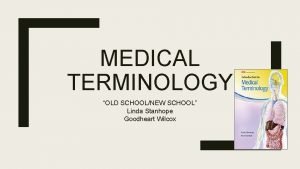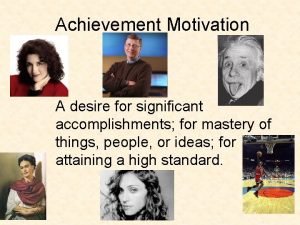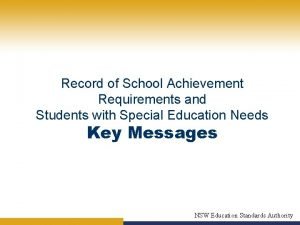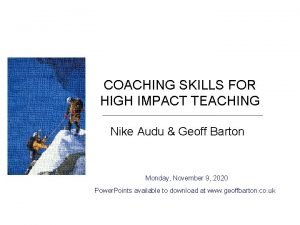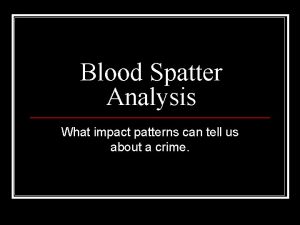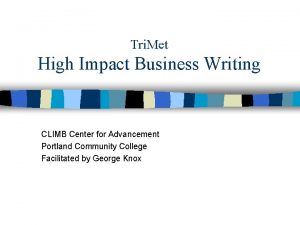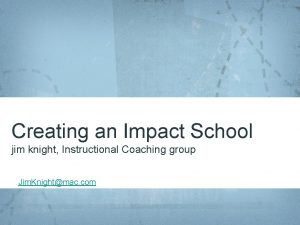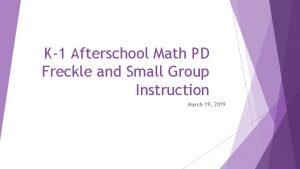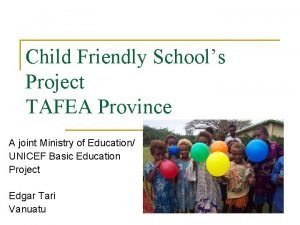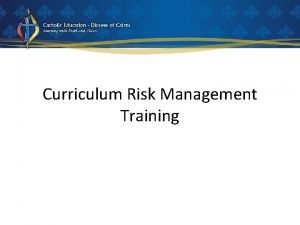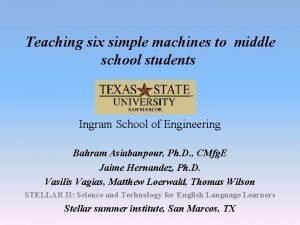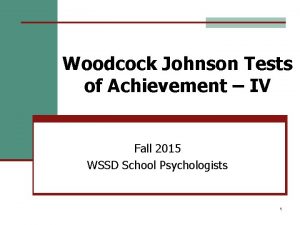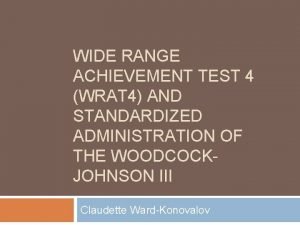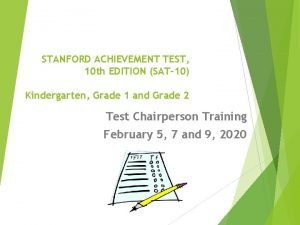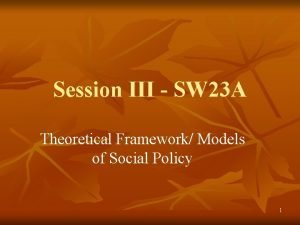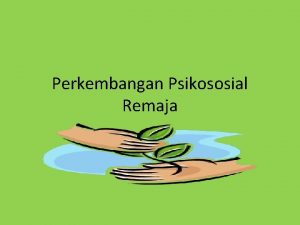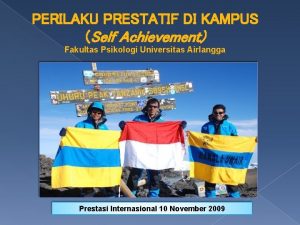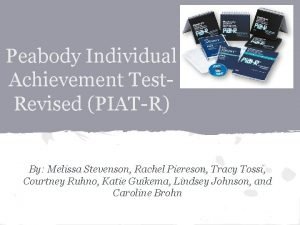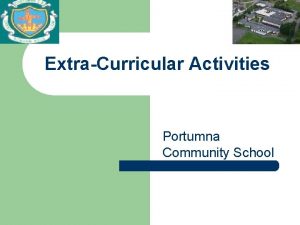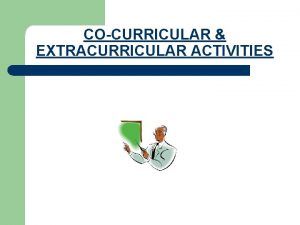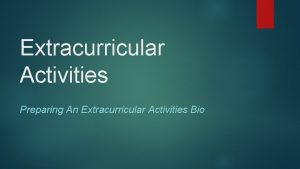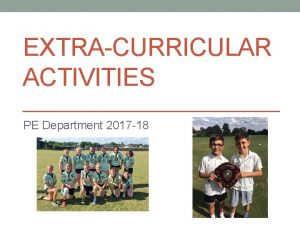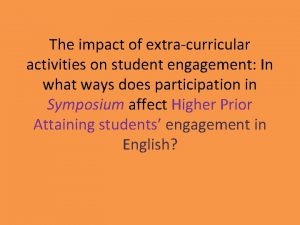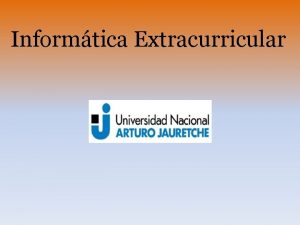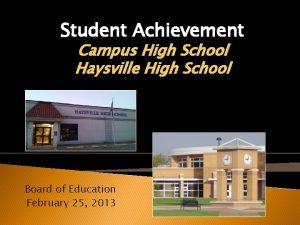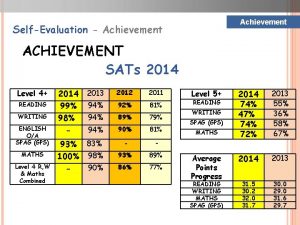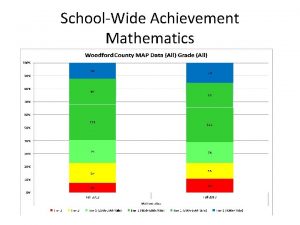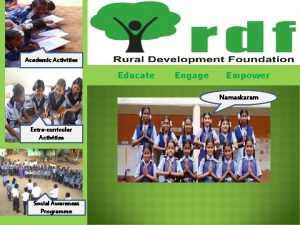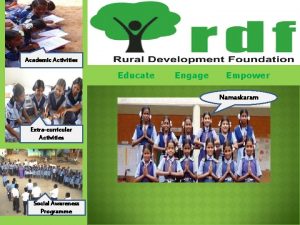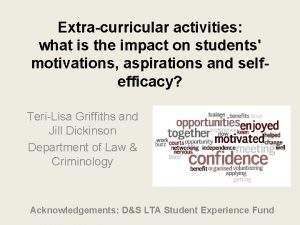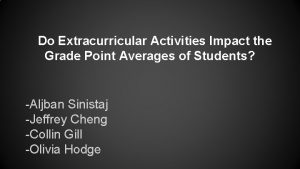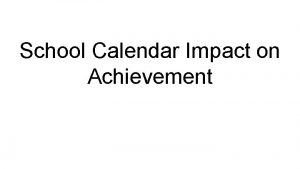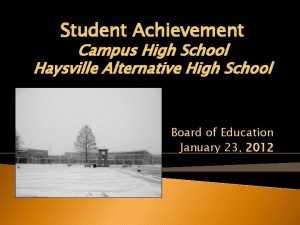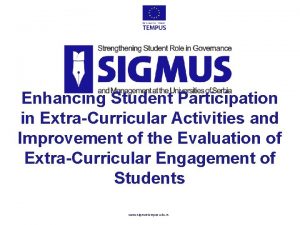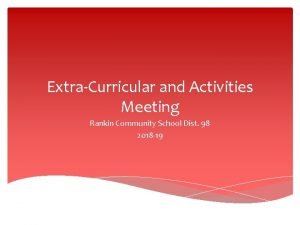High School Extracurricular Activities Impact on Student Achievement























































- Slides: 55

High School Extracurricular Activities Impact on Student Achievement by Kristen Samuelson

Need for Study Studies show that students who participate in extracurricular activities such as athletics, fine arts, and school-sponsored clubs are higher achieving students. l Due to caps in revenue, school districts are forced to divert resources towards getting students to pass standardized tests, thereby cutting athletic funding because of their increasing costs. (Hurley, 2004) l

Purpose of Study l To demonstrate the impact of participation in extracurricular activities on student achievement.

Research Questions l Does involvement in high school extracurricular activities positively or negatively impact student achievement, such as state test scores (TAKS) and course grades (GPA)? l Does it impact student behaviors such as behavior in the classroom?

Hypothesis l Students who participate in high school extracurricular activities have higher state test (TAKS) scores. l Students who participate in high school extracurricular activities get better grades. l Classroom behavior is better amongst students who participate in extracurricular activities.

Operational Definitions Extracurricular Activities – an educational activity not falling within the regular scope of the curriculum. Ex. Athletic team, fine art, or club. l Professional Learning Communities – extending classroom practice into the community or bringing the community into the classroom with the purpose of enhancing the curriculum or learning experience. l TAKS – standardized tests; Texas Assessment of Knowledge and Skills. Ten different tests given throughout high school. l

Operational Definitions, cont’d. No Child Left Behind – educational reform act signed by President George W. Bush in 2002. It stresses greater accountability, more freedom from states and communities, more choices for parents, and encouragement for proven educational methods. l Classroom Behavior – behaviors demonstrated in the classroom by students. Conduct grades given by teachers can affect participation in extracurricular activities and membership into organizations such as the National Honor Society and Student Council. l

Literature Review l When students were asked what they most wanted to be remembered for, forty percent of boys responded that they wanted to be remembered as a star athlete. (Coleman, 2006)

l For over a century, scholars have debated the type of education that students should receive. l Today, we question whether all high school students should receive college preparation or whether they should be able to experience a little bit of everything.

l What has resulted is the idea that high schools offer equal opportunity for a rigorous academic program with the ability to take electives.

l The Bush Administration, as well as the Clinton Administration made education reform a top priority. l The Center on Education Policy reports that student achievement has continued to improve during the implementation of No Child Left Behind, and in many places, the achievement gaps are narrowing. (Schwartzbeck, 2005)

Richard Rothstein, an education researcher and writer, states that the quality of schools has been and continues to be tied very tightly to the level of wealth or poverty of the children the school serves. l His research shows that the greatest variable to increasing SAT scores has been family income. (Houston, 2001) l

l How are educators supposed to create that connection for students between the classroom and their culture? l Situated learning theorists argue that through social interaction and practice, students will be better able to apply knowledge from the classroom to outside school settings. (White, 2003)

l Situated learning relies on human interaction. l Gaining skills and knowledge require practice in the “real world” rather than classrooms or other artificial settings. (White, 2003)

l Current school reform is putting an emphasis on “small learning communities. ” l Schools that have implemented a small learning community also support mentorship, tutoring, homework assistance, college planning and extracurricular activities. (2006)

In addition to the small learning communities, there are collaborative initiatives that are geared towards improving child outcomes. l These programs recognize the importance of establishing partnerships between the child’s home, school and service providers with the intent of monitoring their needs and services. (Brown et al. , 2002) l

l. A recent Phi Delta Kappa/Gallup Poll identified the top reason for the success of some schools as the support and involvement of parents in the school and their child’s education. (Nellen, 2005)

A University of Michigan study shows that the single strongest predictor of student test scores and behavioral problems is the amount of time that children spend dining with their families. (Mattox Jr, 2005)

Contributions from the community comes in other ways besides mentoring, including monetary: l The telementoring has shown positive results and confirms the idea that “we can whenever, and wherever we choose, successfully teach all children whose schooling is of interest to us” (Nellen, 2005). l There is a positive relationship between per student expenditures at all levels of education and the gross domestic product per capita (Wirt et al. , 2002). l

l Almost every high school in America offers extracurricular activities such as athletics, fine arts and clubs. It can be argued that these activities fall into areas discussed previously, collaborative learning, small learning communities, as well as situated learning.

l There are many benefits to participating in extracurricular activities including but not limited to learning the values of teamwork, responsibility, competition, diversity, culture, community, and physical strength and endurance. These activities provide an opportunity for reinforcing lessons learned in the classroom, applying academic skills in a “realworld” context. (O'Brien & Rollefson, 1995)

l In a study by the National Center for Education Statistics, there appeared to be no important differences in the availability of activities between affluent and less affluent schools, large or small schools, rural, urban or suburban schools, and those with great or few minority students. (O'Brien & Rollefson, 1995)

l. A 1992 survey showed that one of every four seniors participated in at least one extracurricular activity. A 1997 study showed that 83% of students between the ages of 6 -17 participated in at least one extracurricular activity. (Ebie, 2005)

l Jerome Bruner says that “we get interested in what we get good at. ” l With extracurricular activities, students are taking the initiative to be there because they want to be there. l Kids will get more out of an activity that they are interested in because they have a stake in it. (Welsh, 2004)

l Participation in extracurricular activities is considered to be part of a well-rounded education and increases students’ commitment and sense of school pride. l Some benefits listed by O’Brien and Rollefson include consistent attendance, academic achievement and academic aspirations.

l Research has shown positive relationships between extracurricular activities and increased self-esteem, lower dropout rates, better attendance, reduction of atrisk behaviors, physical fitness, and as a predictor of success in college and later in life. (Ebie, 2005)

l. A 2003 report by the National Federation of State High School Associations surveyed American high schools regarding athletic participation, and states that 55. 4% of high school students participated in some form of athletic program during the 2003 school year. (Carlson et al. , 2005)

l The National Center for Education Statistics began an eight year study in 1990 that examines the future of high school athletes, after high school. This study proved that there is a positive relationship between high school athletic participation and success.

l Marsh and Kleitman found that participation in high school athletics had a stronger positive impact on postsecondary outcomes than participation in any other type of extracurricular activity. (Carlson et al. , 2005)

l Experts feel that involvement in extracurricular activities provides students the opportunity for a more well-rounded education. l A 2005 Gallup Poll suggests that parents and the public feel that a child with a more well-rounded education is more valuable than a student who makes straight A’s. (Ebie, 2005)

The study showed that students who excelled in music were also high achievers in academics, honors, student government, leadership, athletics, service and extracurricular activities. l The study does suggest that the focused study of music, of value in itself, may enhance confidence and encourage students to be successful in other areas. (Tobin, 2005) l

l Schools are forced to focus on test results and in doing so, have forgotten that what they offer outside the classroom can be as important as what is taught within. As schools rush to improve the test scores, more money is pushed into the classrooms of science, math and social studies, usually at the expense of other programs such as music, drama, athletics, and journalism, sometimes to the point of elimination. (Welsh, 2004)

l The National Association of State Boards of Education kicked off a national research project in December 2005. Their goal is to complete a three year comprehensive and national examination of student participation, the relationship between academic performance and athletic involvement, and the role of coaches in interscholastic competitions (2005).

l The research will focus on student participation data, coaching, and sports in school. Once enough data has been collected, Dr. Michael Hill intends to argue the value of interscholastic athletics and its role in the development of the community, school, and individual student (2005).

Sample l Suburban Houston area high school l Test 1: 3 groups of 100 students each No participation in extracurricular activity Participates in 1 extracurricular activity Participates in 2 or more extracurricular activities l Stratified random sampling

Sample l Test 2: 1 group of 100 students Previously participated in athletics or fine arts program Subsequently been cut, kicked off or quit. l Simplified random sampling

Research Design l Correlational Research Method Test 1: Gauge the relationship between academic achievement and participation in extracurricular activities Test 2: Determine if elimination from an athletic or fine arts extracurricular program results in reduced academic achievement and conduct

Research Procedures l The questionnaire in test one asks students to check each of the extracurricular activities that they are currently a member of. l Based on these questionnaires, students will be assigned a number so that the researcher may use stratified random sampling to form three groups of one hundred students each.

l The first group is comprised of students who do not participate in any school-based extracurricular activities. l The second group of students participates in only one school-based extracurricular activity. l Finally, the third group of students participates in two or more school-based extracurricular activities.

l Grade point averages and TAKS scores will be collected for each student in each of the three groups. l Each group will have a mean GPA and TAKS score calculated for comparison between the three groups.

The questionnaire in test two (Appendix B) is given to faculty members who are coaches or sponsors of athletic or fine arts programs. l They are asked to list the names of students who have participated at least one full year in their program, but have been cut (performance based), kicked off (discipline), or quit on their own (diminished interest). l

l The purpose of the second test is to determine if elimination from an athletic or fine arts program results in lower academic achievement and conduct grades.

Instrumentation The researcher will use a questionnaire in test one, to be given to students during the announcement period following second period. l The questionnaire provides a place for the student’s given name. It lists all extracurricular activities that are currently offered at the high school, grouped into the categories: Athletics; Fine Arts; Clubs. A space is provided next to each activity for students to check if they are currently a member of that activity. l

In test two, the researcher will give a questionnaire to coaches and sponsors of athletic and fine arts programs. l The questionnaire asks these faculty members to search their records from the previous two years and list the names of students who have completed one full year in their program but have subsequently been cut (performance based), kicked off (discipline), or quit (diminished interest) themselves. l

Data Collection The researcher will utilize the school’s registrar to access the records of the students selected for these two studies. l The researcher will input GPA’s and TAKS scores into an Excel spreadsheet (Appendix C) using pre-defined formulas to determine the mean TAKS percentile rank for each student as well as the mean GPA and TAKS percentile rank for each of the three groups. l

l The registrar will provide the GPA’s and conduct grades of each of the students, for the year(s) while they were participating as well as for the subsequent year after elimination from the program. l The researcher will enter the data into an Excel spreadsheet using pre-defined formulas to determine the mean conduct grade for each student.

Data Analysis In test one, GPA’s and TAKS scores were collected for all three groups. GPA’s are based on a 5. 0 scale. Each student’s GPA is current and based on the average of all grades earned while in high school. l TAKS scores are a percentile rank, on a scale of 0 – 100. Students take ten different TAKS tests throughout high school. Each test has a different percentile rank. To compare TAKS scores, each student was given a percentile rank based on the average score of all TAKS tests taken up to this time. l

l In test one, scatterplots will be developed to compare the individual grade point averages in each of the three groups. l Using the mean GPA and mean TAKS percentile rank calculated for each group, bar charts will be created in Excel to compare the differences between the three groups.

l. A scatterplot will allow the researcher to compare the two sets of GPA’s of each student as well as the mean conduct grades of each student. l In addition, a t-test will be conducted to view the difference in the mean GPA and mean conduct grades of the before and after group.

Ethical Issues l Parent and student consent forms must be signed and returned before questionnaires are given out. l Published findings will not reveal student names. l Complete student confidentiality. l Questionnaire should pose no harm to students – will not interfere with instructional time.

l Students may view themselves as a failure since the study is introduced with the idea that participation in extracurricular activities increases student achievement.

Limitations l Not diverse population. l Gender, race, age, SES not taken into account. l Non-school related activities not considered. l Family and work responsibilities not considered.

l Reason for leaving program not taken into consideration. l Elite or novice level before leaving program not considered. l Student participation in different program following elimination not considered.

Possible Implications l Currently, school districts across Texas are cutting funding to extracurricular activities. l If the test in this study supports the hypothesis that student participation in extracurricular activities leads to greater academic achievement, then hopefully administrators will rethink funding policies.

l Some schools have established a “no-cut” policy in order to build a strong foundation for athletic programs. l If the second test supports the hypothesis, then possibly more schools will follow suit and find a spot for all kids to participate.
 Extracurricular activities operational definition
Extracurricular activities operational definition Extracurricular activities conceptual definition
Extracurricular activities conceptual definition Extracurricular activities examples
Extracurricular activities examples 8 learning styles gardner
8 learning styles gardner Proiect educativ
Proiect educativ Informatica extracurricular unaj
Informatica extracurricular unaj Proiect extracurricular
Proiect extracurricular Scholastic achievement manager
Scholastic achievement manager To assess achievement at the end of instruction is
To assess achievement at the end of instruction is American student achievement institute
American student achievement institute Student achievement goals
Student achievement goals American student achievement institute
American student achievement institute Medical terminology lesson plans
Medical terminology lesson plans Achievement motivation is the desire for
Achievement motivation is the desire for Josef a high school student tells his therapist
Josef a high school student tells his therapist Marcus a high school student works at a lumberyard
Marcus a high school student works at a lumberyard Record of school achievement
Record of school achievement Operating activities vs investing activities
Operating activities vs investing activities Now group these activities into indoor and outdoor
Now group these activities into indoor and outdoor Primary and support activities
Primary and support activities Primary activities and secondary activities
Primary activities and secondary activities Site:slidetodoc.com
Site:slidetodoc.com High impact coaching skills
High impact coaching skills Aoi formula forensics
Aoi formula forensics Ged high impact indicators
Ged high impact indicators High impact change model
High impact change model High impact leadership
High impact leadership High impact business writing
High impact business writing Crescenta valley high school graduation 2021
Crescenta valley high school graduation 2021 Haltom high school summer school
Haltom high school summer school Impact school
Impact school Last weekend essay
Last weekend essay What did you do in london last weekend
What did you do in london last weekend Clearinghouse student tracker
Clearinghouse student tracker Class maths student student1 class student string name
Class maths student student1 class student string name National student clearinghouse student tracker
National student clearinghouse student tracker Https://student.freckle.com/#/fact-practice
Https://student.freckle.com/#/fact-practice Good morning student how are you
Good morning student how are you Sls reset password
Sls reset password April school activities
April school activities Trinity activities for sunday school
Trinity activities for sunday school Child-friendly school activities
Child-friendly school activities Child-friendly school activities
Child-friendly school activities Curriculum activity risk management guidelines
Curriculum activity risk management guidelines Simple machines mikids
Simple machines mikids Mudalier commission
Mudalier commission Wj iv score ranges
Wj iv score ranges Wrat 4 grade equivalent table
Wrat 4 grade equivalent table Sat10
Sat10 What is industrial achievement-performance model
What is industrial achievement-performance model Content communicative achievement organisation language
Content communicative achievement organisation language Provincial achievement tests
Provincial achievement tests Tugas stadier
Tugas stadier Self achievement adalah
Self achievement adalah Hse performance achievement template
Hse performance achievement template Piatr
Piatr
